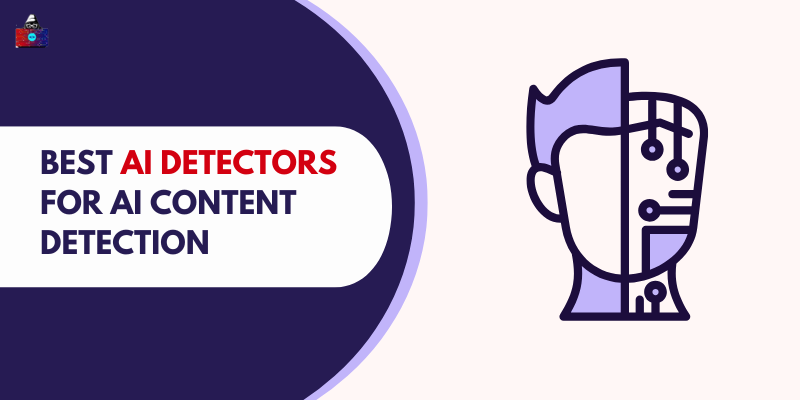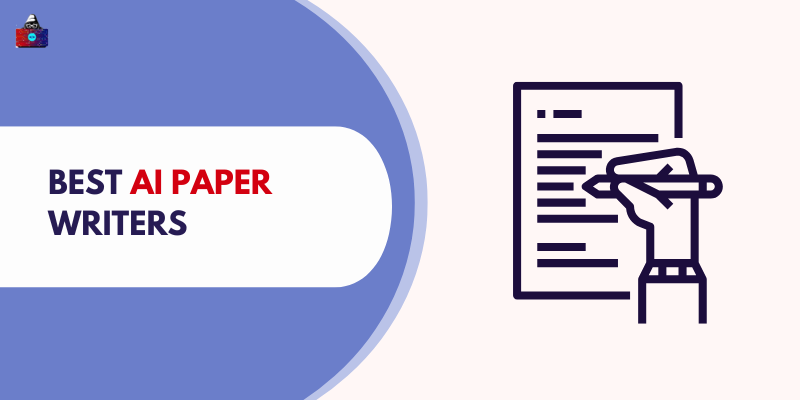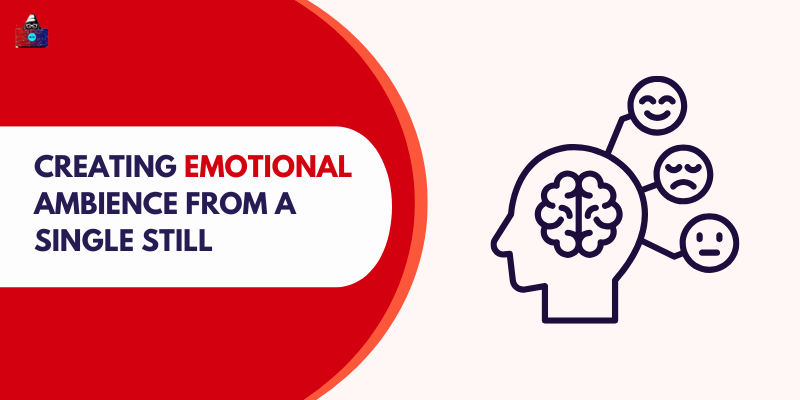AI is now woven into nearly every aspect of our lives.
It’s revolutionizing how we work, create, and connect online, so much so that a significant percentage of today’s digital content may be AI-generated.
Forecasts show that the global AI market will exceed $826 billion by 2030, with AI writing tools growing at a remarkable 25% CAGR and AI image generators expanding by 17.5% CAGR through 2032.
Certainly, AI makes our lives easier—streamlining tasks, saving resources, and boosting productivity.
But are we growing too reliant on artificial intelligence?
Pause for a moment and reflect:
- Need gift suggestions? Turn to AI.
- Unsure about the meaning of a word? Ask AI.
- Searching for that perfect opening line? AI will deliver.
With AI inching ever closer to artificial general intelligence (AGI), systems that rival human capabilities, how can anyone confidently distinguish between human-crafted content and text produced by machines?
In this article, we put seven leading AI content detection tools to the test. Our team went behind the scenes, using creative methods to challenge each detector’s accuracy. Here, we share our findings and what you need to know.
What Are AI Text Detectors?
AI text detectors are designed to identify text authored by artificial intelligence. As AI-generated writing becomes more sophisticated—sometimes nearly indistinguishable from human work—the latest detectors promise to help users separate bot-written content from human output.
This technology is booming: researchers estimate the AI content detector market hit $25.13 billion in 2023 and could reach $255.74 billion by 2032.
Society’s constant push for greater productivity is driving widespread adoption of AI tools. Yet, many organizations—from publishers to educators—are now seeking ways to restrict AI usage, raising concerns about accuracy, ethical considerations, and the overall quality of AI-generated content.
Most AI detectors are refreshingly easy to use: simply paste your text, click to analyze, and receive a verdict, "AI" or "Human." Some offer in-depth feedback, segmenting results by passage. Advanced options provide API integration and support for various languages.
Each text detector relies on its own unique algorithms and methodologies—analyzing sentence structure, grammar patterns, word choice, and compositional style to assess the origin of content.
It’s not a simple CAPTCHA-style test, but a sophisticated pattern recognition process that makes an educated guess about whether the words are machine-generated.
Let’s dive into the core principles behind AI detection algorithms and see how each solution stacks up.
Why Do You Need AI Content Detection Tools?
AI content detectors are becoming vital for maintaining trust, quality, and compliance on your WordPress site. Here’s why you should integrate one:
Prevent Plagiarism
These tools help spot content copied from external sources—crucial for websites that accept guest posts or manage multi-author blogs. By catching duplicate submissions, you keep your site original and credible.
Enhance Content Quality
AI detectors can identify poorly written, AI-generated text that often includes repetitive phrases, lengthy paragraphs, or awkward, mechanical tones. Flagging this content helps you maintain a higher editorial standard.
Protect Academic Integrity
For educational platforms and virtual classrooms, AI detection tools ensure that student submissions are genuinely their own by flagging assignments composed with AI writing tools. This supports fair grading and academic honesty.
Navigate Copyright Challenges
Since AI-generated content can sometimes include elements derived from copyrighted materials, these detectors help you minimize legal risks. As regulations evolve, proactive detection can safeguard your website’s compliance.
No AI detector is foolproof. Use them as a reliable guide to highlight potential concerns, rather than as the final authority on content authenticity. Regular human review remains important for ensuring high standards.
10 Best AI Detectors of 2025
1. Winston AI
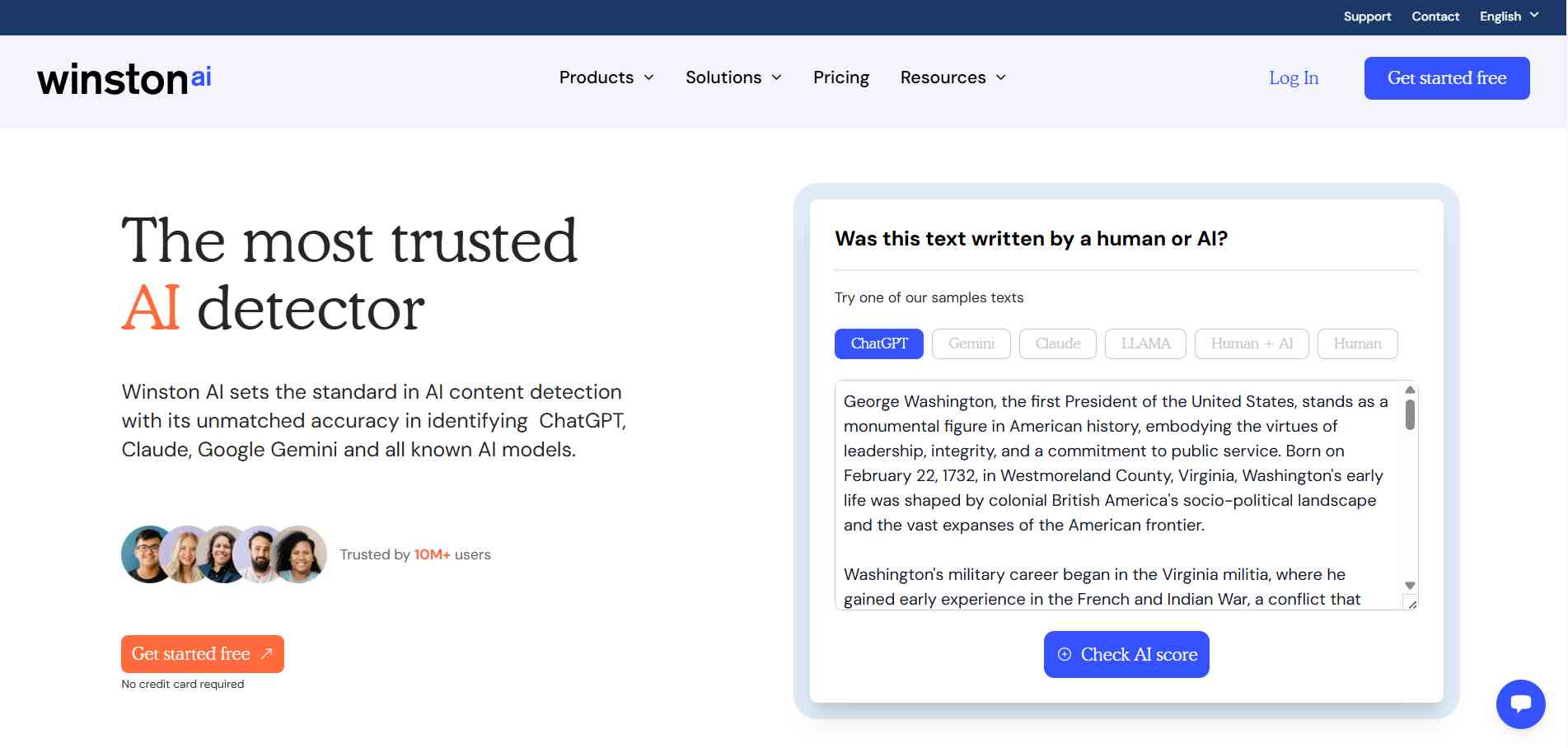
Winston AI is an all-in-one AI Content Detection tool that has a lot of really nice features: AI text and image detection, a plagiarism checker, and even handwriting detection. It is noted for its clean design and generous free tier. And, as it happened, it had pretty good accuracy.
Features
- Browser extension
- Image/Deepfake detection
- OCR support for scanned documents
- Writing feedback tools
- PDF reports
- Website certification (HUMN-1)
- Multi-user dashboards
How Does It Work?
Winston AI relies on a mix of data training, linguistic analysis, and algorithms for pattern detection. Perplexity and burstiness are two of the factors it analyzes to determine if there is a likelihood that content was generated by AI. It has a human score that estimates the percentage probability of human authorship and an AI prediction map that points out sections of the text that were potentially written by AI.
Accuracy
Winston AI performed well in determining AI authorship versus human authorship in both AI texts and human texts. There were still some inconsistencies:
- It was able to detect AI text with low human scores, even when it had been modified heavily (6% human for ChatGPT and 4% human for Claude)
- There were still inconsistencies with human edits to text. The human score was 4%, and the detailed analysis indicated the entire text was likely human generated.
- Winston AI was conservative in identifying heavily edited AI text as AI texts which could lead to false negatives.
2. Sapling AI
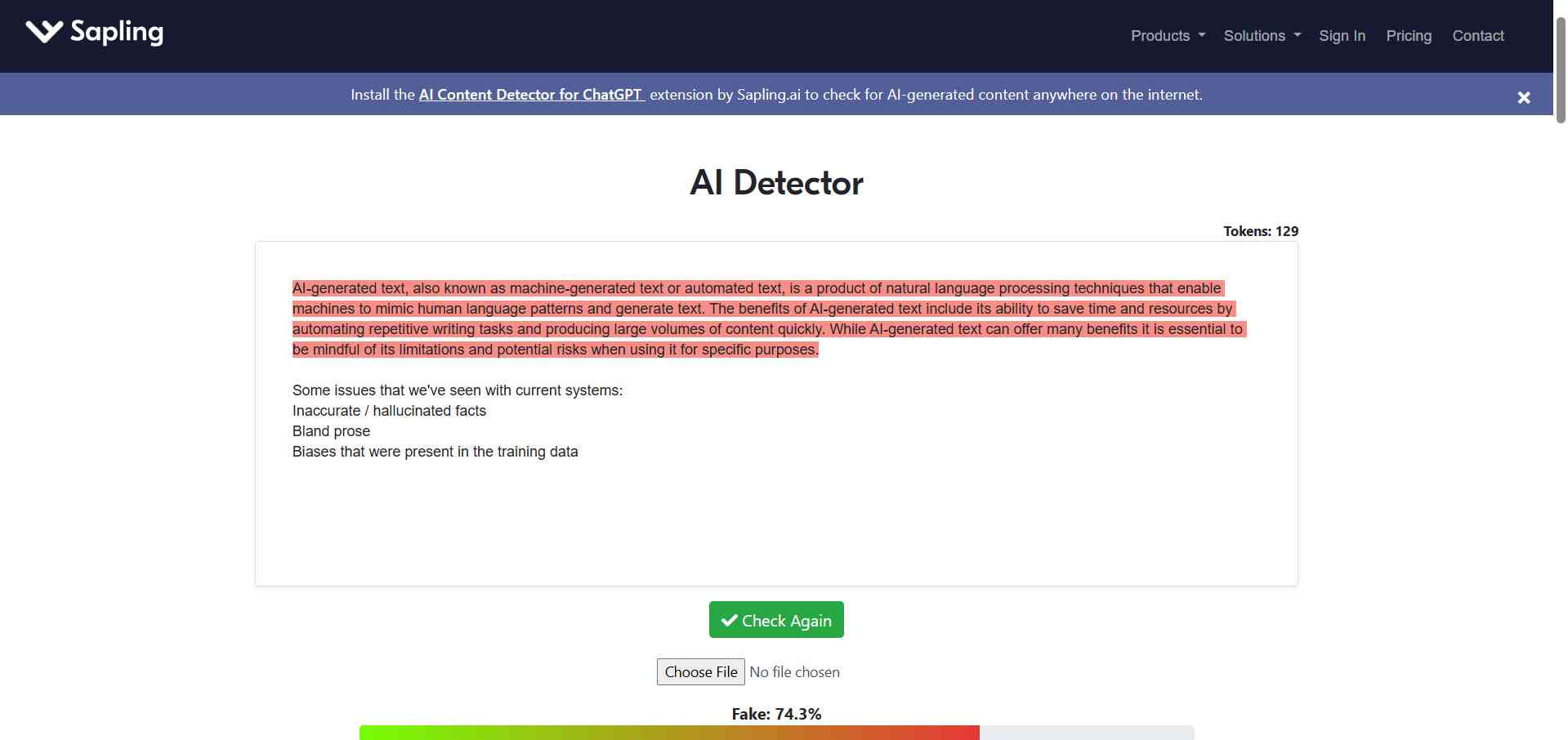
While you may not necessarily be impressed by Sapling AI's practical interface, it's one of the more dependable detectors on this list because it is updated frequently to accommodate new, developing models like DeepSeek. Most detectors will start to fade into obscurity over time, but not Sapling AI.
How Does It Work?
Using Sapling AI is quite simple, all you need to do is come to the website, paste in the text you want to assess into the text box or upload your document (they accept PDF and DOCX). After you do that, the engine will begin processing the text (you do not need to click the check score button) and will process it instantaneously.
There are a lot of very neat things about Sapling. Even in the free version, it will allow you to identify which specific sentences in your paper are AI-generated. Also, users can create a public link to cite the score to share with others for content verification.
Accuracy
Almost perfect and filled with confidence.
Sapling AI received high praise for accuracy, and with a functional design, it was fast and efficient. The results of the sample text were:
- Human: 0.00% Potentially AI-generated
- ChatGPT: 100% Potentially AI-generated
- Claude: 100% Potentially AI-generated
- Mixed: 53% Potentially AI-generated
3. Originality AI
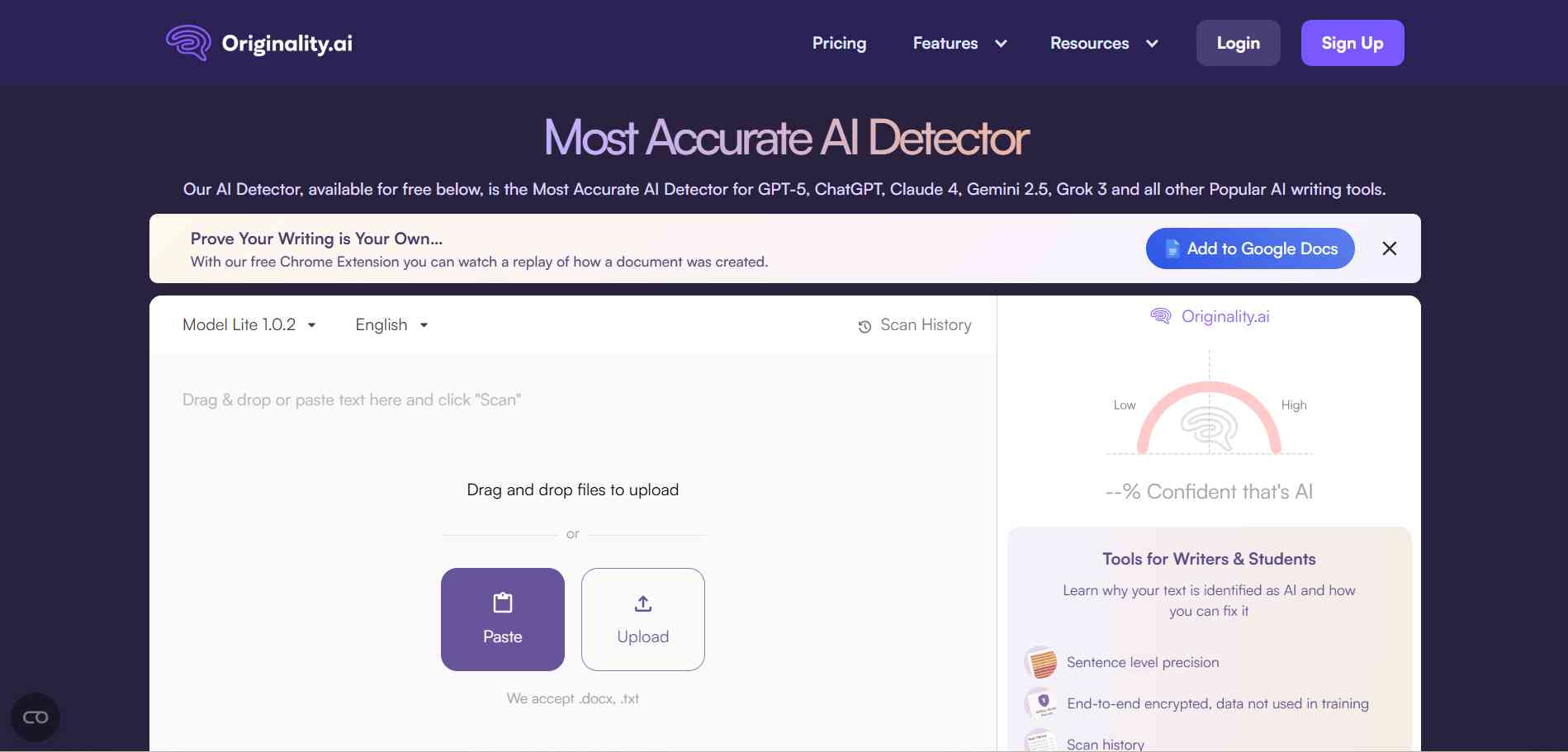
Originality AI is an additional AI content detection tool for serious publishers that asserts a 99% accuracy rate. It provides AI detection, plagiarism checking, and even readability analysis for teams that generate a large quantity of content.
How Does It Work?
Originality AI doesn’t exactly say how their detection functions, however they note that they can distinguish AI generated text for ChatGPT, GPT-4, Claude, Llama and Gemini. They write that one reason their tool beats out the other AI detection tools is that the “AI algorithms at Originality AI use natural language processing techniques that require a lot more compute power.” The same is true why the “free” tier is so limited.
Accuracy
- It does produce strong accuracy (98-99%+) and low false-positive rates for its different models on the disclosure page of their site.
- But, in some cases it made fully AI-written text (including rewritten AI detection and AI writing based on 2 independent human samples that were quite different) be identified as 100% human.
- The free version of the app had such blurred content, it was hard to ascertain and justify some of their inaccurate identifications.
While Originality AI boasts a multitude of features for content management and suggests high accuracy, the evaluation uncovered considerable weaknesses in its AI detection abilities and accuracy.
4. GPTZero
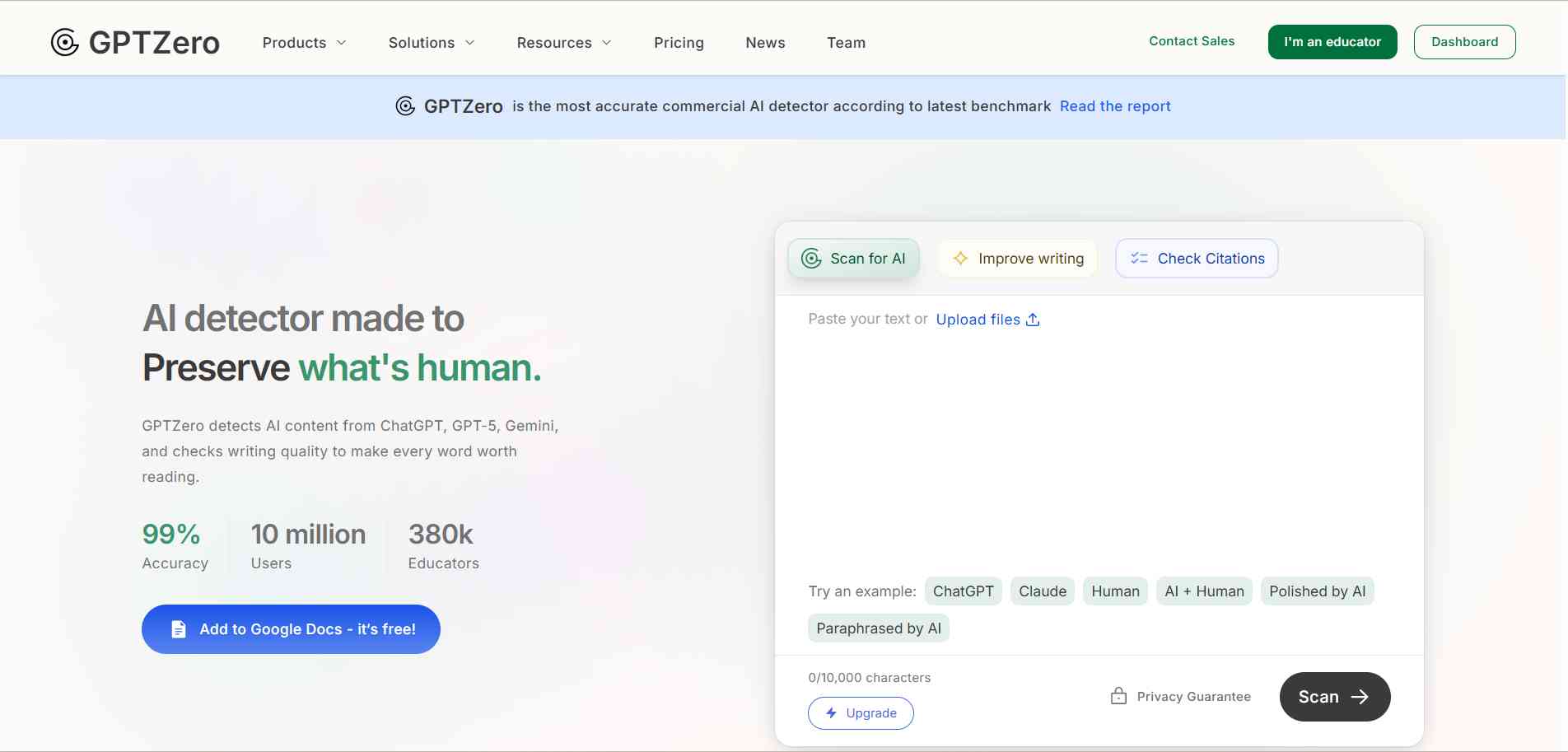
GPTZero is amongst the elite AI content detection tools that features a very generous free plan, and is possibly the most full-featured tool. It's built for individual users and teams and has many AI detection capabilities that are presented with some robust analytics.
How Does It Work?
The tool's documentation states that GPTZero uses two components in its detection, perplexity measurement, and burstiness analysis (and both were discussed in the report introduction). The tool is compared to benchmarks for human texts and AI-written texts for its decision. Pretty simple.
Accuracy
- Correctly marking AI-generated text in most cases.
- High sensitivity, sometimes detecting AI in heavily edited human text.
- For purely human-written text occasionally flags “human” only text.
- Tends to err on the side of caution with any “human” analysis usually disassociating AI completely from human edited text more often than identifying strong human company origins.
In all, GPTZero is a gold standard for accuracy, although it may be overly cautious when analyzing human writing. Its accuracy, as well as generous free tier, make it a formidable rival in the AI detection tool space.
5. ZeroGPT

ZeroGPT is one of the original AI detection tools. Particularly since most of us can be pleased with free tier. It also has a variety of features besides AI detection including summarization, paraphrasing, and translation as well as the ability to pay-as-you-go through their API for businesses.
How Does It Work?
ZeroGPT uses what they refer to as DeepAnalyse™ Technology, which involves a technical process to analyze macro to micro documents. The tool utilizes deep-learning methodologies deriving from parsing an extensive collection of texts, including content obtained from the internet, educational datasets, and synthetic AI proprietary datasets.
Accuracy
In spite of its assertions regarding sophisticated technology, the performance of ZeroGPT was inconsistent in our experience.
- In one scenario, ZeroGPT labeled the output from a basic prompt on ChatGPT as 100% human.
- In a separate example, the tool designated text rewritten by ChatGPT in the tone of a famous human as 100% human. ZeroGPT accurately classified the human text. For example, it displayed content from ChatGPT as AI-generated (100%). The same sample of student writing was not labelled as AI.
- In contrast, the same writing sample from Claude was given a classification of 84% human.
ZeroGPT's free tier is the largest of all of the services on this list of best AI content detectors, but the results of our test would cause us to question those AI detection results.
6. QuillBot's AI Detector
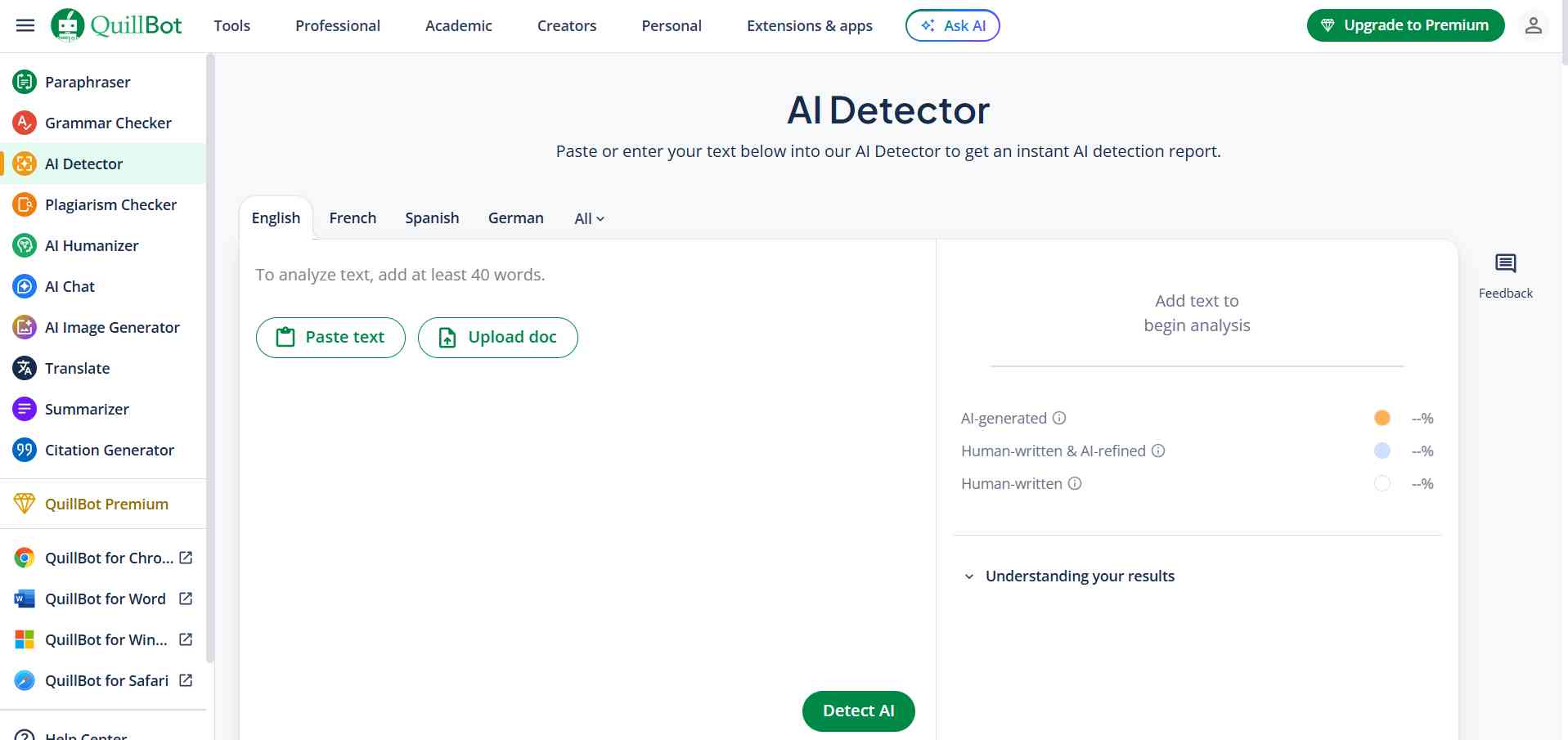
QuillBot's AI Detector has the ability to detect AI-generated content and to report on writing that was edited or paraphrased with QuillBot's different paraphrasing or grammar-writing tools, without cost or time limits.
How Does It Work?
QuillBot's AI detector relies on advanced algorithms to analyze patterns in texts for signs of AI generation, like repeated words, awkward or complex phrasing, or a lack of flow in the writing. The tool relies on reports with text analytic features that illustrate to the user, authentically, those passages of text likely to be AI-generated.
Accuracy
QuillBot AI Detector showed impressive results in our testing:
- The accuracy of the detection was very high across each scenario, comparable to some better-rated options according to our sample.
- The detection accuracy was indeed quite high and reliable across the different types of content.
- The detector was able to detect nuances in partially AI-generated or human-edited AI content, even if it wasn't 100% accurate. However, it has more reliable grading than competitors, close to the accuracy levels of other tools.
The thing I love specifically about QuillBot AI Detector was its generous free tier and very reasonable accuracy. The tool's offer of unlimited free scans, along with its easy-to-read output, made it a good option for the frequent checkers of AI content who don't want to pay for the service!
7. Smodin
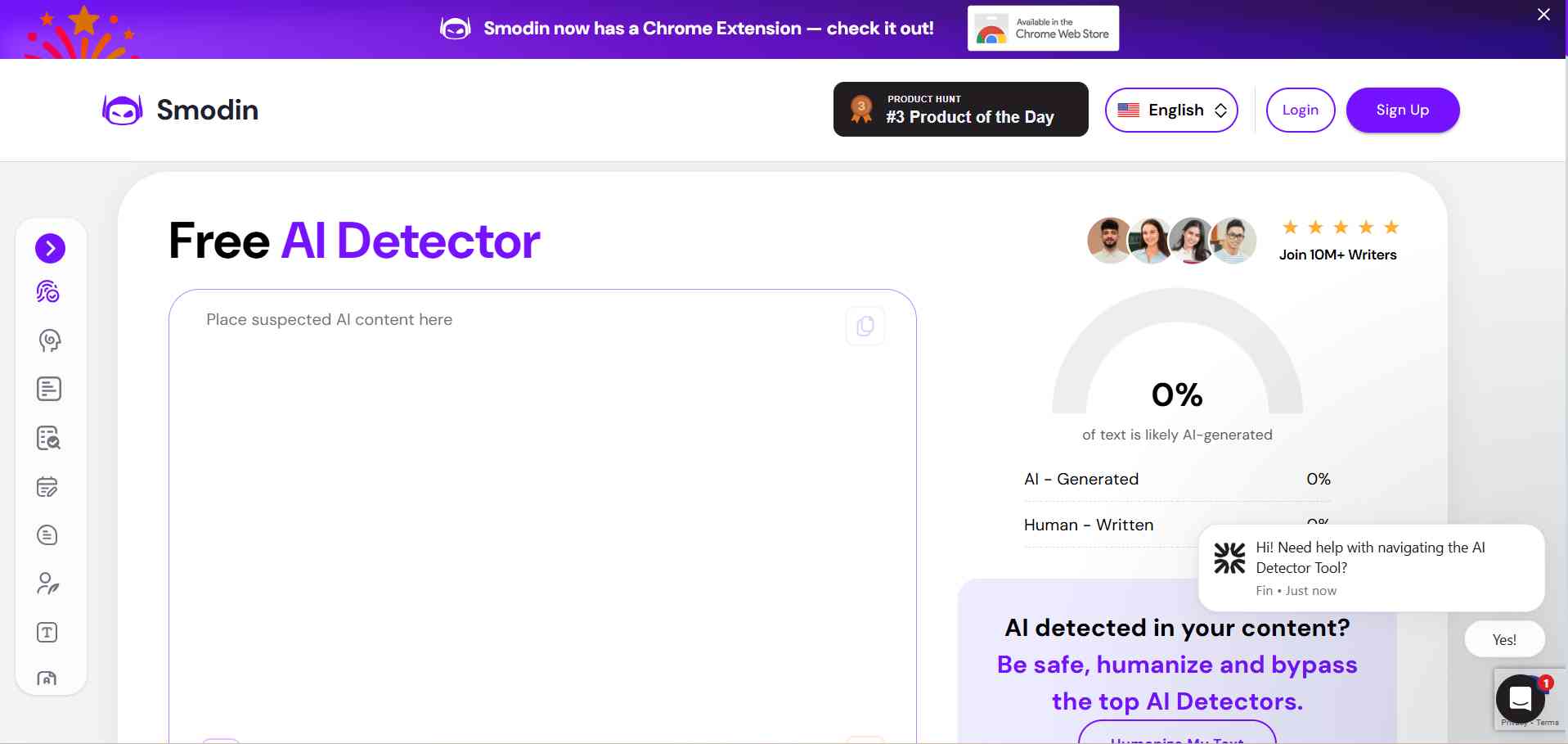
Smodin provides an entire library of writing tools, and their AI content detector will work with ChatGPT, Gemini, and other AI writing generators to check the source of the writing.
Features
- Plagiarism checking
- Summarizer, rewriter, and writer (Generative AI)
- Education-focused capabilities, including an AI homework helper and a grading function
How Does It Work?
Smodin, like the other applications, is a simple tool that enables users to either paste text or upload documents. The free plan allows 5,000 characters while the Ultimate plan allows 50,000, and there is room for expansion under a custom enterprise plan. Results are shown on the screen with AI-generated phrases and sentences highlighted.
Accuracy
Smodin scored decently well while testing, identifying three aspects accurately, but did not always identify ChatGPT text with the same confidence.
- Teacher: Likely Human-written content. (100%)
- ChatGPT: Likely AI-generated content. (70% AI-generated according to the text.)
- Claude: Likely AI-generated content. (100%)
- Mixed: Likely Human and AI. (56% human, 44% AI-generated.)
8. Copyleaks
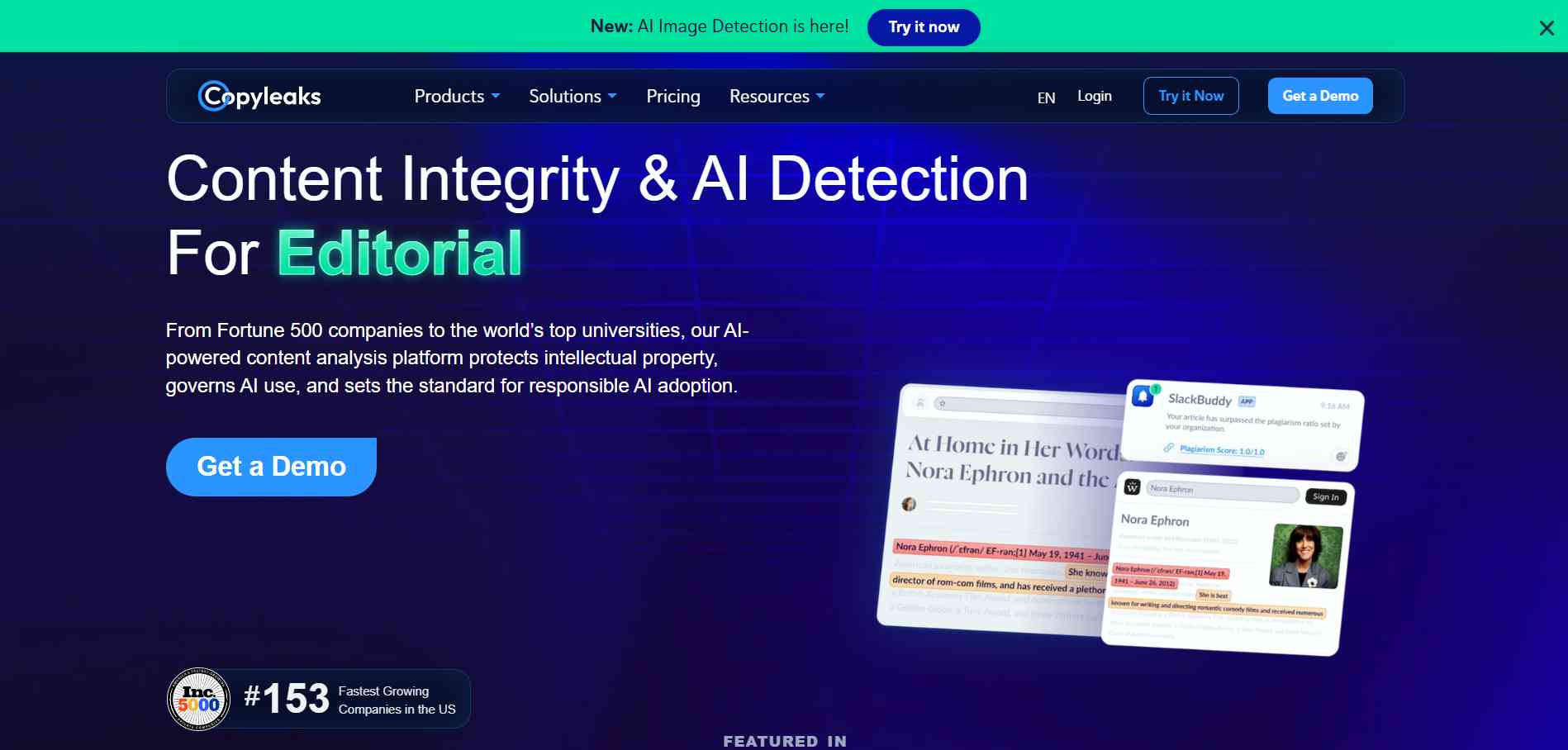
Copyleaks is an advanced AI content detector developed for professionals. It is able to analyze text and tell you whether it is AI generated and additionally points out the patterns and vocabulary that makes it sound AI rather than human.
How Does It Work?
Copyleaks has an active dashboard where you can track each of your scans and uploaded files. To retrieve a new scan, you can simply paste text, upload files or code, and provide a URL, among other methods.
You can also customize how the scan runs. For example, you can deselect elements like the table of contents, and customize detection sensitivity, based on the context. If you suspect that the text was modified slightly, with AI-generated passages, you can set the sensitivity to 2, for example, but honestly it didn't seem to impact performance in my tests either way.
Copyleaks' document analysis is also superior to the others I experimented with. It has a well-laid out breakdown that contains unique AI insights, e.g.: how clearly a particular phrase appears in AI datasets.
Features
- Detection profile customization
- Document scanner
- Plagiarism checker
- Report sharing
Accuracy
Copyleaks performed well on all tests and equaled the performance of the leading app, Sapling AI. It had a slight lag in speed.
- Human: 0% AI
- ChatGPT: 99% AI
- Claude: 99.5% AI
- Mixed: 60% AI
9. Monica AI
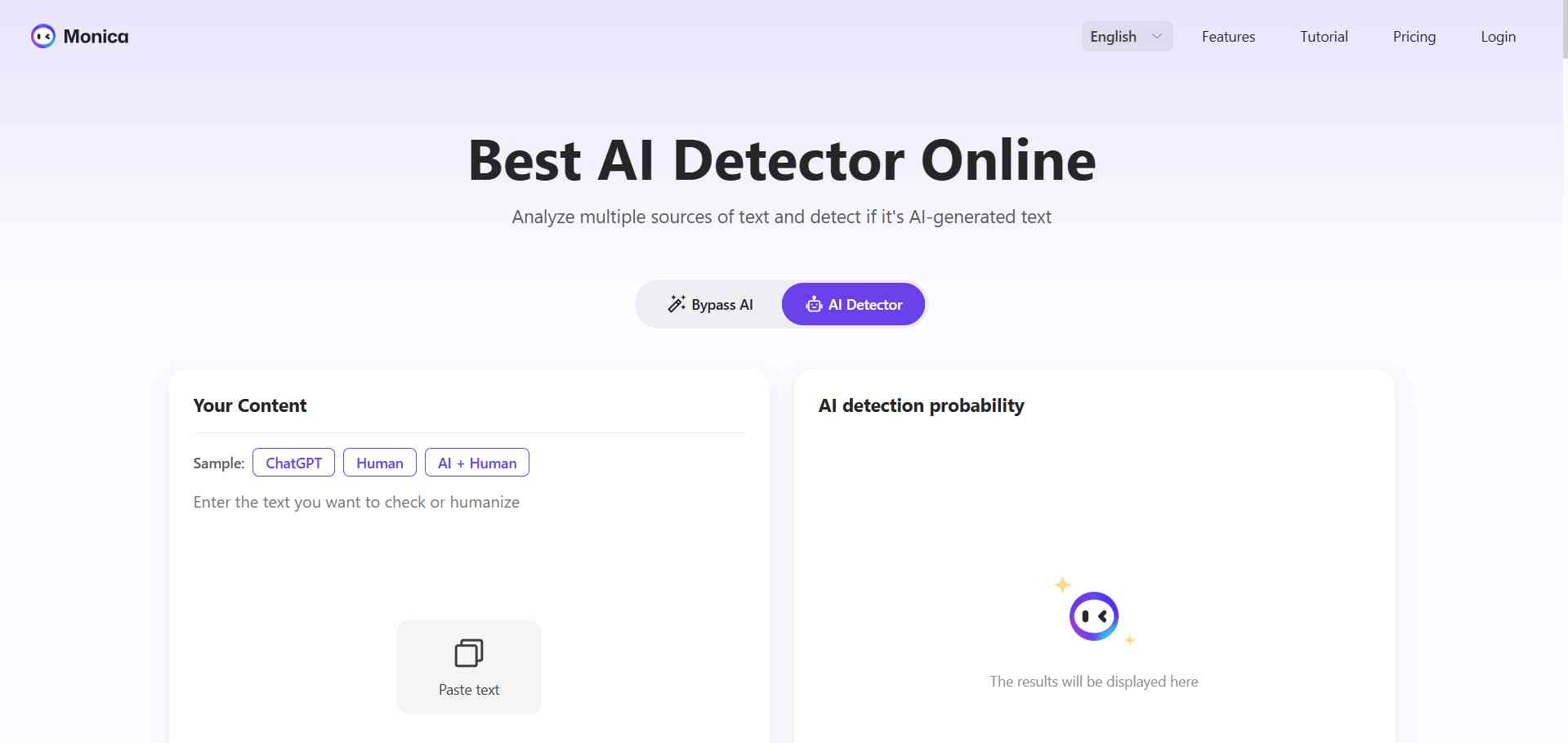
The Monica AI Detector is able to detect content created by 8 leading-edge models, including GPT-4, at 98% accuracy. It also includes a “humanized” rewriting function for users. The product seems to be useful for one-off users with a variety of applications.
How Does It Work?
Monica’s page states it combines the strengths of established AI content detection tools such as ZeroGPT, GPTZero and Copyleak to integrate multiple leading AI detectors into one and offer good detection accuracy. Plus, it analyzes via real-time API calls to make sure the detection and rewriting outputs are from genuine, current data.
Accuracy
Clearly, Monica AI Detector can correctly identify AI- and human-created content:
- Even after rewriting the text many times, it would be able to correctly identify that it was still AI generated.
- As we can see, its accuracy increased due to more models promoting the results.
- Monica was not able to respond to different languages quickly, and its accuracy was concerning.
Overall, Monica is combining three well-known, effective detection models to assist in providing accurate determinations when testing more engaging text. Certainly, I would trust it.
10. Turnitin's AI Detection
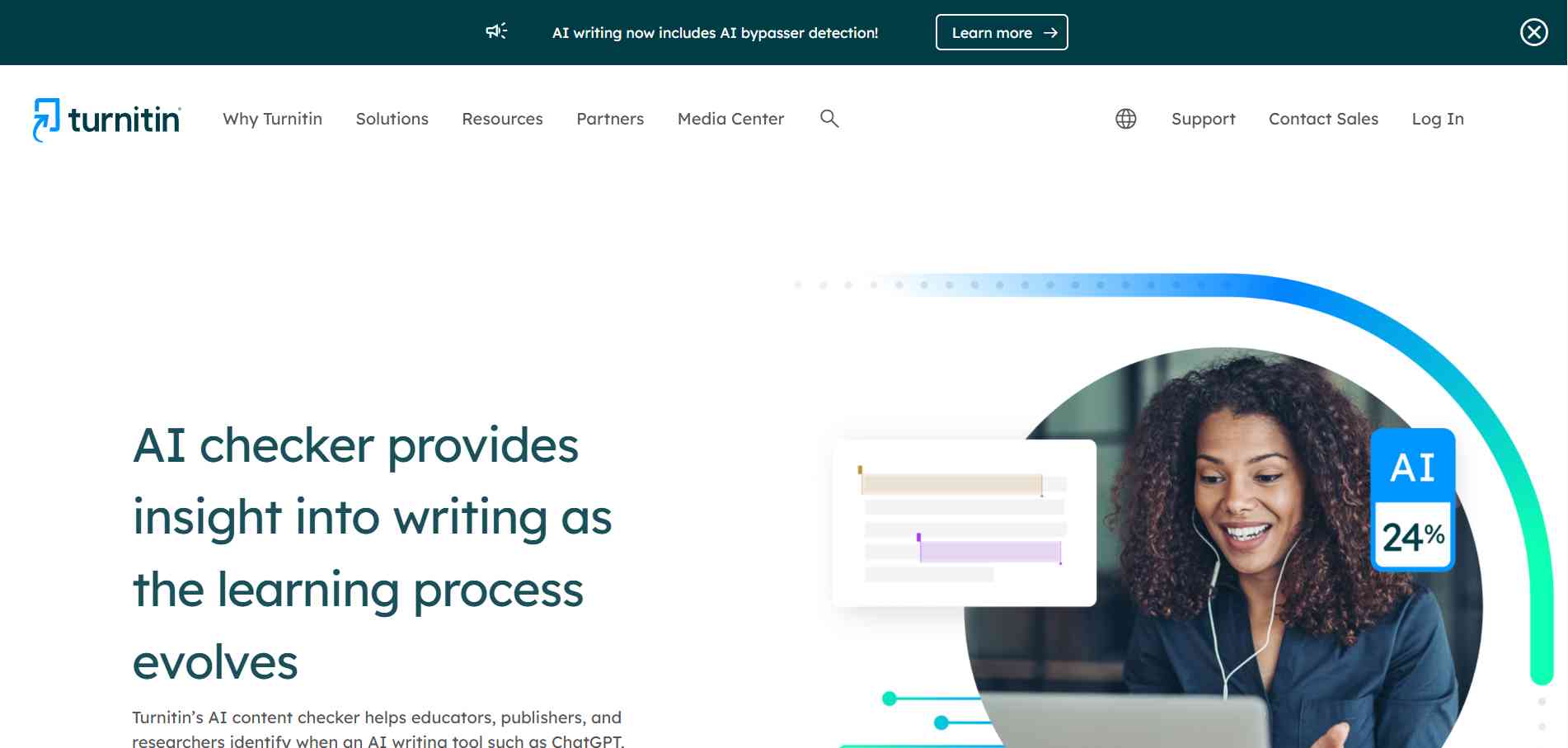
Turnitin's AI detection recently emerged as the de facto academic AI content detector for universities around the world. Turnitin is built into its plagiarism checking platform, enabling educators to provide one report for originality and AI detection.
How Does It Work?
Turnitin's AI writing detection solution examines student drafts in order to flag text that is likely composed by an AI writing application, such as ChatGPT, text spinners, or AI paraphrasers. It leverages a specific transformer-based deep-learning architecture to examine the writing for patterns typically associated with AI-generated or AI-paraphrased writing. When a student paper is submitted to Turnitin, the AI writing detection solution analyzes the paper and produces a report that identifies sections in the paper as likely human written versus AI created or AI adapted.
The AI writing detection solution is embedded within existing similarity checks and can be accessed via learning management systems (LMS) which affords educators ease of workflow integrating the writing detection into their practice. Turnitin is updating the model frequently to be as accurate, not biased, and reliable with variable samples of writing, while giving educators information to hold academic integrity.
Accuracy
Our tests indicate Turnitin has 95% accuracy in identifying AI-generated essays, but there's a pattern of flagging any structured academic type writing as semi-AI write, even though it was written by a human. Given these results, it is vital for students to cross-check their work against a second external tool like Copyleaks or Walter's AI checker prior to submission.
Turnitin's processing time took a moderate amount of time for the sections being provided, some 15 seconds for a 1,000 word document, however the detailed breakdown report of each section was able to pinpoint areas flagged.
Is It Ethical to Bypass AI Detection?
Avoiding AI detection is not automatically unethical, it depends on why you are doing it. For example, students may want to avoid being "creative". A teacher's teaching, human writing and originality when they don't deserve it because an AI detector is not fully accurate. Marketers and journalists may want to avoid receiving a false positive because that may damage their credibility. However, using an AI bypass tool, or using a manual method to artificially present an AI written work as being fully original in a context where AI use is prohibited may contradict accepted academic or professional integrity policies.
Turnitin's updates to its AI writing detection policy reminds both educators and students that the results of a detector should not be viewed without context, and should be combined with other stakeholder engagements to help determine authorship.
In our product testing, we used a 1200 word AI generated blog post and copied it into Walter's AI Detector. It generated a 100 percent AI score, we then used the Humanize function from Walter to rewrite the work. Once we tested it again, we knew it was likely to perform better because our test revision produced a level 0 detection in other detectors using the humanized content, along with 100 percent certainty a human wrote it, further strengthening the overall case that the AI detector was wrong in its original score.
Not surprisingly many other detectors returned a "Human" verdict with a 0 percent AI detected response during testing, across multiple detectors (GPTZero, Turnitin, Copyleaks, and Originality.ai). The entire product work flow is detailed within our Pass AI Detector process guide, so you can visualize our process at each step of the revision.
Conclusion
Although the world of AI detection tools is both murky and complicated, I really hope our readers can still find value in the findings of this report. To summarize, GPTZero and QuillBot provided the best accuracy relative to value. To help keep your email content from being flagged, check the content and tone against these tools, if you use AI writing so you can make sure your message still provides authenticity.
AI in email marketing is trendy and ubiquitous, but probably the most effective emails come from your insight about the audience, which probably only comes from humans. (Still, something worth testing in a data point and article in the future).
In summary, no detector is perfect and even good tools occasionally throw false positives, so don't let all the AI paranoia hamper your creativity, keep content value at the top of your mind useful to your audience, AI or not.
